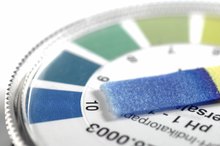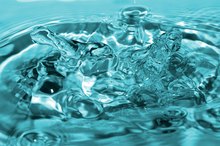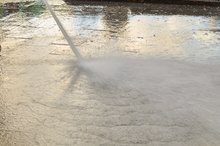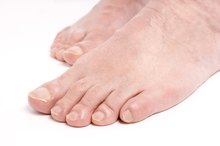Hydrochloric Acid and Swimming Pools
Maintaining proper water chemistry in your pool is essential for health and safety. One of the most common pool chemicals is hydrocholoric acid, often known as muriatic acid. It is a very strong acid used to lower the pH or total alkalinity of the water. It can also be used as an acid washer for cleaning an empty pool.
Pool Chemistry
The pH level of your pool affects every other chemical balance in pool water. pH is a measure of the level of hydrogen ions or acidity of the pool water. Measured on a logarithmic scale, a pH of 0 indicates extremely acidic conditions, and a pH of 14 indicates extremely basic conditions. A pH of 7 is neutral. The most desired pH of pool water is between 7.4 to 7.6, slightly basic. This is the most comfortable range for your eyes and skin, and provides the optimum chlorine levels to prevent bacteria, algae and fungus growth, without developing scale, the white crusty substance often seen on pool tiles, or becoming too corrosive. Hydrochloric acid is often used to adjust pool water back towards this optimum range when it has become too basic.
Importance of Optimal pH
Effects of Sodium Hydroxide in a Swimming Pool
Learn More
Hydrochloric acid is necessary to adjust the pH to optimal levels. When pool water becomes too acidic-- conditions of low pH--chlorine levels decrease, eye irritation occurs, plaster walls become etched and the metal fittings, heating core and pool pump can corrode. The dissolved metals can stain the walls of the pool. Likewise, when pool water becomes too basic, chlorine activity becomes slow and inefficient; scale from mineral precipitation out of the water can form leaving a hard white residue on the pool tile, the pool water becomes discolored and cloudy, the filter has to work harder and eye irritation can occur.Sodium bisulfate can also be used to lower pH, but hydrochloric acid provides the added benefit of increasing the free chlorine concentration in the water.
Free Chlorine
Free chlorine oxidizes and sanitizes impurities that enter pool water. When chlorine is added to pool water in the form of Cl2, it forms both hypochlorous acid or HOCl and hydrochloric acid or HCl. At pH levels above 6.0, hypochloric acid will dissociate into hypochlorite ions or OCl- ions. Hypochloric acid and hypochlorite ions are called free-available chlorine or FAC. FACs are extremely effective at killing bacteria. Once hypochloric acid combines with impurities, it forms chloramines, and is no longer free. Chloramines have less than one percent of the sanitizing power of FAC molecules. As much as 25 times more combined chlorine than free-available chlorine may be needed to produce a 100 percent bacterial kill with the same contact time. Chloramines have a distinctive odor and are very irritating to your eyes and skin.
Safety
What pH in Water Is Too High for Human Consumption
Learn More
Hydrochloric acid is extremely dangerous. It must be added at the deep end of the pool being careful not to splash the concentrated solution directly onto pool walls or fittings. You should wear rubber gloves and safety glasses when working with hydrochloric acid. Vapors may irritate your respiratory tract. Always add the acid to the water; never add water to the acid.
Calculations
When calculating how much hydrochloric acid is needed to neutralize your pool water to the optimal pH range, you need to know the volume of the water in your pool. You can roughly estimate this volume by knowing the length, width, depth and shape of your pool and using simple geometric calculations. Then, using a variety of online calculators, such as the one provided by Pool Wizard, you can estimate how much hydrochloric acid you need to add to your pool to reduce the alkalinity by a specified amount.
For example, a 23,000-gallon pool has approximately 87,000 liters of pool water and would require about 1.4 liters of a 30 percent hydrochloric acid solution to reduce the alkalinity by 10 parts per million.
Related Articles
Writer Bio
Robin Wasserman has been writing and prosecuting biochemical patents since 1998. She has served as a biochemical patent agent and a research scientist for a gene-therapy company. Wasserman earned her Doctor of Philosophy in biochemistry and molecular biology, graduating from Harvard University in 1995.









